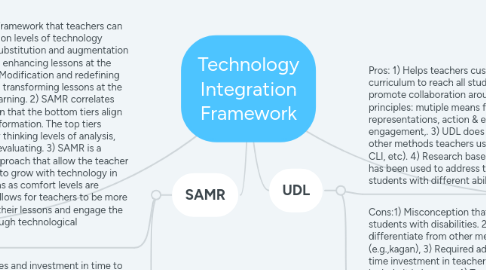Technology Integration Framework
by JoseLuis Mejia

1. TPACK
1.1. PROS:1) It makes teachers aware that technology, pedagogy, and content need to merge in the center to produce effective lessons. 2) It’s a tool that allow teachers to match technology with each content (not a one size fits all model). 3) It’s a flexible framework that helps integrate technology to various content to increase information processing, communication, and problem-solving. 4) Having a choice in technology can remove constraints for teachers.
1.2. Cons:1) Its flexibility is limited to the teacher’s proficiency in the three elements (Technology, Pedagogy, and Content). If a teacher is struggling in any of these areas then TPACK will not work effectively. 2) Another issue is that technology is always in flux and that can affect the level of technology knowledge (TK) with teachers. 3) Another issue is that technology may not be made for educational purposes and teachers have to find ways to adapt them to student learning. For example, excel and powerpoint were made for the business word, yet teachers have used it to enhance lessons. 4) TPACK also requires teachers to constantly be aware of the equilibrium of the three elements (this may require additional and ongoing professional development).
2. SAMR
2.1. Pros: 1) Easy framework that teachers can use to reflect on levels of technology integration. Substitution and augmentation correlate with enhancing lessons at the bottom tiers. Modification and redefining correlate with transforming lessons at the top tiers of learning. 2) SAMR correlates with Bloom’s in that the bottom tiers align to recalling information. The top tiers require higher thinking levels of analysis, creating and evaluating. 3) SAMR is a scaffolded approach that allow the teacher and students to grow with technology in the classrooms as comfort levels are gained. 4) It allows for teachers to be more innovative in their lessons and engage the students through technological collaboration.
2.2. Cons:1) It requires and investment in time to train teachers on how to use SAMR into their lessons. 2) Teachers may not be strong enough in technology to reach the higher levels of Blooms. 3) Technology may not fully target the needs of the content that students need to learn (e.g., using technology just to use it). 4) The limitation of technology in the classrooms
3. LoTi
3.1. Pros: 1) It’s offers the Digital Age survey that is free to educators so that they can be reflective in their technology integration (over a million educators have taken it). 2) It’s a comprehensive assessment that rate schools/teachers on 5 domains (LoTi, H.E.A.T, instructional framework, Digital Age best practices, ISTE standards). 3)It helps schools measure (quantify) the levels of each domain with specific details and recommendations. 4) It focuses on 21st century learning (critical thinking, collaboration, problem solving, and self-directed investigations) to increase student academic achievement.
3.2. Cons: 1) The LoTi profile report can be overwhelming and needs to be chunked into data. 2) The rating system (level 0-nonuse to level 6 refinement) can be blurred when there are multiple sections being factored into each domain. 3) The data may not make sense to teachers that are struggling to integrate technology and are in the non-use to awareness levels. You have teachers that are strong in content, but lack technology (they are still effective). 4) The amount of PD would be invested in reading the 40 plus page report.
4. UDL
4.1. Pros: 1) Helps teachers customize curriculum to reach all students. 2) Helps promote collaboration around three principles: mutiple means for representations, action & expression, and engagement,. 3) UDL does not conflict with other methods teachers use (e.g., kagan, CLI, etc). 4) Research base approached that has been used to address the needs of students with different abilities & needs
4.2. Cons:1) Misconception that it is only for students with disabilities. 2) Hard to differentiate from other methods (e.g.,kagan), 3) Required additional PD and time investment in teachers to intentionally include it in lessons. 4) Traditional teachers may struggle to make the necessary change (requires committment and follow through).


